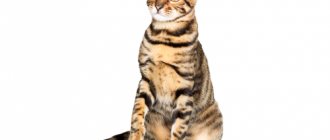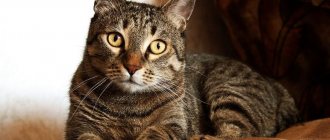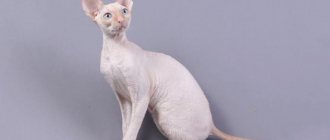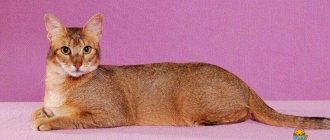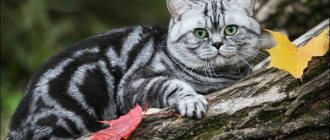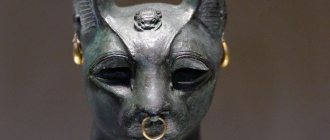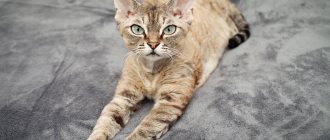Description of the Peterbald cat breed
Popularity 26th place among 86 cat breeds
Lifespan:
13-15 years old
Height:
25-30 cm
Country of origin:
Russia
Average price:
20-100 thousand rubles
Weight:
3-5 kg
Latest articles Cat care
How to trim a cat's claws correctly and easily 01/28/2022 133 0 0
Dog health
How to do an ultrasound for dogs: preparation and procedure 01/28/2022 62 0 0
Flock
This variety lacks mustaches and eyebrows, but they have a small coat of fur that does not exceed 2 mm.
The Peterbald with wool is also very popular; caring for it is a little easier, because almost the entire body is covered with a thin layer of hair.
Key facts
“Petriki”, which is what the owners call their pets, is a young breed that appeared on the territory of Russia in the city of St. Petersburg. These are very graceful representatives of the cat family who prefer to receive love from their owner in the form of gentle touches and strokes. The purring and demanding voice of the Peterbald can be heard at any time of the day.
Their slightly sticky skin has a higher temperature than their hairy counterparts. Thanks to this, they can perfectly warm their beloved owner during the cold season.
Increased thermoregulation led to a literally brutal appetite in these elegant individuals. Due to their irrepressible energy, figurines, vases and flower pots are in danger of being destroyed.
“ Due to the abundance of protein secreted by saliva, Peterbalds cannot be considered hypoallergenic creatures.
History of the origin of the Peterbald breed
The hairless St. Petersburg cat was the result of crossing two breeds - the Don Sphynx and the Oriental. Attempts to create new representatives occurred in 1994. Felinologist from St. Petersburg Olga Mironova, as a result of crossing two different breeds, received four kittens: Sissy, Mandarin, Muscat and Nocturne from Murino. It was this hybrid offspring that became the ancestors of modern Peterbalds.
The international community liked the breed so much that just 2 years later, international organizations began to issue permission for its breeding. The last one to receive recognition from the WCF was in 2003.
Although the cats have been standardized, a reference representative has not yet been obtained. The breed continues to develop. It is curious that the main goal of breeders is not to obtain a hairless pet. For them, the external characteristics of the animal are important: oriental appearance with features of Orientals and Siamese.
What does a Peterbald look like?
Representatives of this breed are real top models of the cat world. The appearance of the pet leaves no one indifferent. Just look at their dreamy look and bat ears!
Muzzle
The Peterbald's head is wedge-shaped, tapering as it approaches the nose. The long muzzle of the St. Petersburg Sphynx is distinguished by a slightly convex profile and a flat forehead.
The ears are large, widening at the base. They seem to be an extension of the cat's face.
Almond-shaped eyes are slanted, which looks very interesting. According to breed standards, the iris can be green or bright blue. Moreover, the last color is typical for the point color.
St. Petersburg sphinxes do not have mustaches - or they are presented in the form of broken, crimped hairs.
Body type
Peterbald boasts a graceful physique, which does not exclude strong muscles that cover the entire body of the animal. The silhouette line is very elegant. The neck has a graceful curve and elongated shape. The hips are slightly wider than the chest.
The front and hind limbs of representatives of this breed have an ideal straight shape. They are thin and quite long. Paws are oval. Fingers are flexible.
The whip-like tail has a pointed tip. This part of the body is thin and long.
Size and weight
According to standards, the weight of the St. Petersburg Sphynx can be in the range from 3 to 5 kg. These are average sizes, so you shouldn’t expect the kitten to grow into a cat that is too large or too graceful.
Varieties according to undercoat length
The Peterbald is characterized by soft skin that fits loosely around the entire body. Folds form on the skull. The St. Petersburg sphinxes inherited the “bald” gene from their Don brothers. However, some individuals may have sparse and very short hair.
Based on the length of the undercoat, Peterbalds are divided into:
- Hairless, whose skin feels like rubber to the touch. Discharge forms on your pet's skin. They create a thin brown coating on the surface of the body.
- Flock - absolutely beardless and eyebrowless individuals with very short fur. Its length should be no more than 2 mm and be the same throughout the entire body.
- Velor, the peculiarity of which is the presence of short or semi-long wool. As the kittens grow older, it may disappear. Then cute furry socks appear on the paws.
- Brush-pointed - individuals with a hairless or flocked body. The muzzle, paws and tail are covered with stiffer hairs.
- Brushevyh - the pet's body is covered with crimped hair. Animals may be partially or completely pubescent. Brush representatives become bald in the back and neck areas as adults.
- Straight-haired variettes are animals that have not inherited the hairless gene. They have the same coat and whiskers as regular shorthair cats. These kittens are cheaper.
In addition to the listed species, there are also subspecies. For example, flock point, velor point and others. In addition, it is very difficult to figure out what type of kitten will be in adulthood.
Colors
In accordance with the standards, Peterbalds can be color-point and oriental colors. Individuals of the first type have the following colors: cream-point, torti-, lilac-, seal-, tabby-, chocolate-, seal-, blue-.
Oriental type can be: cream, tabby, red, tortoiseshell, chocolate, bicolor, black or blue.
Disqualifying faults
Because it is a new breed, standards continue to change. However, the already identified main disadvantages of the St. Petersburg Sphinx are:
- too fragile physique;
- forelimbs of a curved shape;
- absence or a small number of folds of skin on the skull.
Different coat options, partial or full, as well as hairless type are acceptable, as they can correspond to flock, velor or other subtypes.
Differences from other sphinxes
If you look at photos of Peterbalds, you will hardly be able to find differences between cats from St. Petersburg and their Don counterparts. In fact, St. Petersburg sphinxes are much more miniature creatures. Their body is somewhat more refined and graceful. Don Sphynxes can weigh up to 7 kg, while Peterbalds only gain 3-5 kg. The grace of the Petrikovs is similar to the elegance of the Orientals.
Owner reviews
My cat never wakes me up, but sits next to me and waits as long as necessary until I wake up. He enjoys catching mice and always brings back his catch to show off. I often give my little one chicken meat, paws and heads, as he loves natural food. He has a rather cool attitude towards dry food.
The St. Petersburg Sphynx really has a canine character. He constantly wants attention, and therefore follows on his heels. If you sit down somewhere, the cat will immediately sit next to you. He is unforgiving. Pays attention to other household members only when I am not at home. And usually he always pesters only me. My cat is a real good guy.
Angelina
My cat's name is Valya. She has a very loud and sometimes even unpleasant voice. She usually yells when something doesn't suit her. Loves the company of people. If you accidentally close it in a room, it will immediately start making noise. He always sleeps next to me. There is not an ounce of selfishness in her, which can often be found in other cat breeds. Peterbald is a great friend and companion. These pets get along well with both people and other animals.
Alyona
Almost a year ago we were given a St. Petersburg Sphynx cat.
We decided to call him Druzhok. Quite quickly we managed to accustom him to the tray. I have never been capricious. But the harm appeared within six months. My friend became arrogant and spoiled. This probably started because we always forgive him. He loves the affection of his owners and even strangers. Sometimes he tries to kiss. Although harmful, he is kind. Katerina
Personality of Peterbald cats
Cats from St. Petersburg are extremely open and sociable. Mustachioed friends have a good-natured character, so they are not prone to feline manifestations of revenge.
However, excessive affection can become burdensome. It is vital for Peterbalds to sit on the lap of their beloved owner and faithfully look into the person’s eyes. It is curious that pets quickly become attached to people, so changing owners is not a big problem for them.
“ Despite their sociability and good nature, mustaches can turn into real bald demons. This happens in those families where little time was devoted to high-contact animals.
Peterbalds are very curious. Thanks to their flexible, almost “monkey” fingers, they can crawl into any crevice, open packaging they are interested in, or even pick up the zipper of a handbag.
Possible problems
Despite the lack of hair, the main problem of sphinxes is saliva and allergies to it in humans, especially in children. Peterbalds lick themselves often and a lot, the drying saliva evaporates and can cause allergic reactions and diseases, including bronchial asthma. Exfoliating skin particles are also a strong allergen.
Peterbalds require careful care and proper nutrition, which entails serious financial expenses. Animals are designed to live exclusively within four walls; any contact with the outside environment is undesirable.
It is not recommended to have St. Petersburg Sphynxes for those who are almost never at home - animals cannot stand loneliness, suffer and become depressed, even to the point of death.
Raising a Peterbald
Highly intelligent animals are very trainable. Representatives of the St. Petersburg breed are happy to carry out the commands of their beloved owner. And if you present everything in a playful way, then learning will be even better.
The most basic commands that pets execute can be “Come to me!”, “You can’t!” The most persistent owners ensure that cats bring them balls or other toys.
Before starting training, it is important to consider the mood of your pet. After all, no amount of treats or affection will make him follow orders if he doesn’t want to do it.
“Socialization and habituation should begin immediately after the animal arrives at home. Kittens need to be accustomed to extraneous noises and sharp sounds. A hairdryer, vacuum cleaner and other household appliances should be perceived calmly by children.
Peterbalds are excellent travelers. They like to accompany their owner on long trips. True, for a very small animal, long journeys will be a real test.
St. Petersburg Sphynxes get used to the litter box without any problems. Some pets are able to learn to use the toilet. The owner just needs to buy a special pad for training, gradually raising it to the level of the toilet. Experienced cat breeders advise not to rush and accustom them to using the human toilet in stages.
Peterbald breed health
Possible diseases
Since the Peterbald is a fairly new breed, it is too early to talk about the presence of hereditary diseases in animals. However, over time, information about genetic defects may become available.
Breeders are already talking about a possible predisposition of St. Petersburg Sphynx cats to pulmonary diseases. Heredity may also explain other physiological defects. So, tortoiseshell, cream or blue cats have gum hyperplasia.
Otherwise, the graceful pets are quite healthy. Of course, they are susceptible to seasonal colds, skin diseases and eye problems. But all this can be solved with care and regular visits to the veterinarian.
The main thing that the Peterbald owner should pay attention to is changes in the quality of the fatty lubricant. If its color, smell or consistency becomes unusual, then some problems occur with the animal’s body. It is better to contact a veterinarian who will conduct a full examination of the eared patient and prescribe treatment if necessary.
Reproductive health and breeding
Mating is best done in the male's territory. In this case, the cat will be calmer, and the process may end successfully. Only fully mature individuals should be bred. Females are ready to reproduce healthy offspring at the age of 1-1.5 years. An earlier pregnancy can have a negative impact on the physiological and psychological state of the mother cat.
On average, 4 to 5 kittens are born in a litter. If the cat is not intended for breeding (pet class), then it is better to resort to castration.
Buying a kitten
St. Petersburg sphinxes are currently in moderate demand. In Western countries, this breed has not yet found wide distribution. St. Petersburg beauties have just begun to gain popularity.
In Russia now there are not so many nurseries engaged in breeding Peterbalds. The price of kittens that do not fall under the exhibition criteria ranges from 5 to 15 thousand rubles. The cost of exhibition copies can reach up to 40 thousand rubles.
Small representatives of the breed can be adopted only after they reach three months of age. If you separate a kitten from its mother earlier, it will be difficult for it, which can affect its health.
Peterbalds are suitable for a responsible owner. Kittens must be treated with special care, monitored and all required procedures carried out on time. This breed also needs a lot of affection. The owners of such cats give them love, and in return receive much more of this bright feeling.
Features of feeding and diet
Natural nutrition
Graceful individuals are real gluttons, ready to eat anything. They happily eat chips, buns, and sweets that an inattentive owner or his family members left unattended. Because of this, the animal's digestive system is constantly under threat.
Cats are practically omnivores, so feeding them natural food is not difficult. The main task of the owner of the St. Petersburg Sphynx is to monitor the balance of his pet’s menu.
The basis of the animal’s diet should be protein, which gets into the bowl in the form of lean beef, chicken or fish fillet, and offal. In addition, boiled and chopped vegetables and cereals should be added to food. Oatmeal, rice, and buckwheat are best suited for feeding your pet.
Peterbald should not be given:
- tubular bones;
- fatty meats, especially lard;
- raw meat and offal;
- fish with a lot of bones;
- sweets;
- smoked meats and pickles;
- baking.
The number of feedings also needs to be controlled. Kittens up to 1 year old can be given food 3-5 times. Since animals at this age are overly active, they quickly burn through calories. But cats older than 1 year should eat no more than 2 times a day, otherwise they cannot avoid obesity and deterioration of their health.
Ready-made feed
Dry or wet industrial food is also suitable for the diet of St. Petersburg individuals. The main thing is to choose only high quality products for the animal: super-premium or holistic.
The animal must be provided with all the vitamins and minerals necessary to maintain a healthy and beautiful appearance. Cheap food is not suitable for the diet of St. Petersburg cats - they can cause digestive disorders and have a bad effect on the skin.
It is necessary to provide Peterbald with constant access to clean drinking water. Moreover, it should be filtered or bottled - but not from the tap.
Temperament of the St. Petersburg Sphynx
For those people who are thinking about purchasing a Neva Sphynx, it would be useful to understand the features of this breed:
- Experts often call this animal a “cat-dog”, since its habits are more reminiscent of a dog’s - they follow their owner with their “tail”, are able to learn the simplest commands, are smart and amenable to training.
- They are loving towards all family members and do not tolerate loneliness well.
- They are affectionate, capable of waiting for the owner all day, sitting at the door and joyfully rushing towards him. They know their name well and respond.
- Talkative too much. If you love a calm, measured life, then it is unlikely to be possible with the St. Petersburg Sphynx. The cat almost always “talks”, expressing all his feelings and emotions.
- Since the Peterbald cannot be left alone at all, you will have to find him a playmate, and he will get along with absolutely any pet.
- They are very playful all their lives and are happy to join children in noisy fun.
- Smart and cunning. They easily learn to open everything - bags, drawers, doors to the room, and even the refrigerator.
- They are unusually voracious, which is due to their physiological characteristics.
- Clean, excellent hunters.
When choosing this pet, you need to remember that you won’t be bored with it and balance your habits and inclinations with the cat’s temperament.
Care and maintenance
Bathing and drying
Caring for the St. Petersburg Sphynx depends on the length of the undercoat. For straight-haired and brushed Peterbalds, the maintenance is somewhat different from how hairless pets are cared for.
Copious discharge appears on the skin of bald individuals. They form a sticky coating that protects and protects the skin from minor injuries and negative environmental influences. Therefore, you should not try to wash off the secretion of the sebaceous glands from your pet’s body.
Washing too often dries out the skin and can lead to flaking. Of course, a Peterbald needs to be bathed more often than a regular cat. But in case of slight contamination, you can simply wipe the dirty area with a clean cloth moistened with oil for caring for baby skin. When choosing shampoos, you should choose Ph-neutral ones - or even better, purchase a special product at a pet store.
Due to excessive work of the sebaceous glands, acne and pimples form near the tail. But such a skin nuisance is only possible in case of insufficient care. Excess must be removed at least once a week using special cleansing lotions or wipes. Subcutaneous wen should be removed - but this can only be done by a veterinarian in a clinic setting.
Cleaning teeth, eyes and ears
These parts of the St. Petersburg Sphynx's body require special care. So, a lot of secretion is formed in the animal’s ears. However, this does not mean that they constantly need to be cleaned with napkins or cotton swabs. Excess secretions should be removed no more than once a week, using lotion from a veterinary pharmacy for the care procedure.
The same product should be used to remove the sebaceous plaque that forms between the folds of the skin and between the claws. The resulting secretion can accumulate and interfere with the animal's movements.
The eyes of a hairless individual are not protected by eyelashes. Therefore, moisture in the form of tears forms on them more often than ordinary cats. Hairless pets with insufficient care may develop a thick secretion with a jelly-like consistency. This nuisance must be removed daily: it is advisable to do this in the morning with a clean cloth or napkin.
The need to wear clothes
Due to the scarcity of fur or its complete absence, Peterbalds are quite frozen creatures. The most comfortable temperature for them starts from +23°C.
A regular bedding or bed will not suit them. The best habitat for pets is a closed house with a comfortable rug inside. It must be installed on an elevated surface to provide protection from drafts.
“ For a comfortable existence, Peterbalds also need clothing. It must be put on immediately as soon as the temperature in the house drops below +22°C. Clothing should be made of soft fabrics that will not harm the animal's skin.
Before important exhibitions, it is advisable to refrain from wearing new clothes for a while to avoid chafing. In any case, you can choose knitted clothes or a suit for the animal, the seams of which are made outward.
Tips for choosing a kitten
Purchasing a pet with such an unusual appearance should be especially thoughtful. If the future owner has never owned hairless animals before, then it is better to get to know them better first. Not everyone will like sticky skin with a characteristic odor. But if this does not bother you, then you can look for a proven nursery.
Of course, you should only buy an animal from reliable breeders with an excellent reputation. Otherwise, you can purchase a false Peterbald dog suffering from unpleasant genetic diseases.
“ It should be taken into account that kittens of some colors, for example, color point, are born white. Their future color can be seen on the nose, ears, paws and tail only after a week.
Most St. Petersburg cats acquire a “finished” appearance only by the age of 1.5-2 years. Therefore, it is important to look at the exterior of the baby’s parents before purchasing it.
Main characteristics
The main distinguishing feature of the Peterbald breed is its hairless, compact, somewhat rectangular body with a wide chest.
The Peterbald's head tapers towards the nose. The forehead is flat - forms a straight line in profile.
There is no transition from the muzzle to the skull.
The eyes are large and almond-shaped. The nose is rounded, does not protrude forward and is not set back.
The wedge shape can be seen throughout the entire shape of the skull and the contour of the ears. The narrowest part - the nose begins to widen, moving into the cheekbones, and then into the outer edge of the ears.
The ears themselves are very large and widely spaced on the skull. This is what forms the wedge shape of the head. The tips of the ears are strongly rounded, which, together with the rounded eyes, gives the cat a soft appearance.
The toes are elongated, which further creates an image of grace and elegance.
How much does a Peterbald cat cost?
Because of their novelty and uniqueness, representatives of the breed are included in the TOP 20 most expensive cats in the world. The cost of a kitten starts from 20,000 rubles. For this amount an animal with simple colors is sold without the right to further mating.
A champion cat with an excellent pedigree and exotic color is sold in the range from 50,000 to 100,000 rubles. According to advertisements, you can buy a baby for 8,000-10,000 rubles. However, such an animal is unlikely to meet the standards of a graceful cat.
Do you like the article? 0
Breeding
You can purchase a Peterbald kitten in nurseries or by advertisement from private individuals. The price of these beautiful animals depends on the pedigree or the popularity of the nursery where you want to purchase the animal. Basically, the price for this cat is from 4,000 rubles. The appearance of the kitten depends on the appearance of its parents. For example, if you cross an Oriental Shorthair with a hairless Peterbald cat, the kittens will only be brush and flock. If both parents are Peterbalds, their children will be mostly flocked and hairless.

